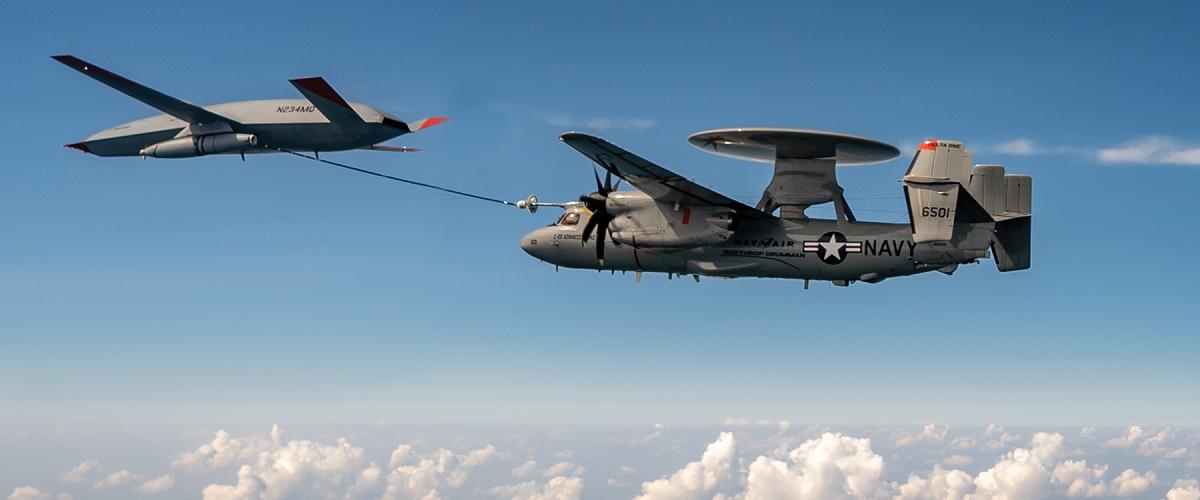
At the Naval Institute’s July 2022 “Maritime Security Dialogue: Naval Aviation Update,” Rear Admiral Andrew J. Loiselle, director of the Air Warfare Division on the staff of the Chief of Naval Operations (OpNav), articulated what has long been discussed regarding the MQ-25 Stingray, stating that it will initially be a tanker, but that the Navy has “not nailed down an exact concept of operations.”1 The MQ-25’s initial performance goal is to deliver 16,000 pounds of gas at a distance of 500 nautical miles (nm) from the carrier.2
Much ink has been spilled in Proceedings on the possibilities of this aircraft, but most of it has discussed those possibilities in speculative terms or in broad strokes concerning unmanned naval aviation in general.3 Others have thoughtfully proposed specific ideas on what the future of unmanned carrier aircraft should look like.4 More recently, a group of authors made clear the MQ-25’s value as a tanker and the prominent role it will play in enabling deep-strike missions for the air wing.5
Many have advocated for the MQ-25 to serve as a deep-strike asset, citing its low-observable features, long range, and lack of a human pilot in harm’s way.6 Indeed, some have argued that the MQ-25 would revive the deep-strike mission that the Navy lost when the A-12 Avenger program was canceled in 1991 and the A-6 Intruder was retired in 1997.7 Although the A-6 and the A-7 Corsair II performed superbly in attack roles, their range and payload were greater than anything the MQ-25 seems likely to demonstrate in the near future. Going back to the 1950s and ’60s, the A-3 Skywarrior and A-5 Vigilante evolved their focus on attack to emphasize refueling, electronic warfare, intelligence surveillance, and reconnaissance.
There are, however, incremental changes that could be made to the MQ-25 or a similar, follow-on platform and the associated concept of operations. Instead of pining for a stealthy, carrier-based unmanned aerial combat vehicle with long-range, capacity for heavy payloads of weapons and sensors, and greater maneuverability than modern fighter aircraft, the Navy should evolve the MQ-25 to complement—not replace—manned aircraft currently on the flight deck.
Multirole Carrier-Based Aircraft: A History
History shows the enduring value of multirole fighter/attack platforms, such as the F4U Corsair in World War II, the F-4 Phantom in Vietnam, and the F-14 Tomcat, which launched some of the first long-range strikes into Afghanistan in 2001. The F/A-18 and F-35 both have the payload, sensors, and existing tactics and training to execute attack missions, and the latter’s stealth capability greatly increases its survivability and utility as a strike asset.
The MQ-25, on the other hand, “wasn’t designed for speed, maneuverability or stealth,” and, although it “could carry weapons” in its mission bay and has “payload capacity for mission growth in the future,” why use limited resources and risk developing it into a strike aircraft?8 Weapons probably would be carried externally, further limiting its ability to penetrate contested airspace.9 It would be more prudent to develop the MQ-25 into a multirole support platform, taking a page from some of the most versatile aircraft to see service on Navy flight decks.
The Navy has a long history of developing multirole carrier-based aircraft that provided support to fighter-bombers. The TBF/TBM Avenger matured from a torpedo bomber to an aircraft capable of antisubmarine warfare (ASW); intelligence, surveillance, and reconnaissance (ISR); airborne early warning (AEW); and electronic warfare (EW). Thus, to guide MQ-25 development, it is essential to consider the histories of the AF Guardian, A-3 Skywarrior, S-3 Viking, and A-6 Intruder.
The Grumman AF Guardian
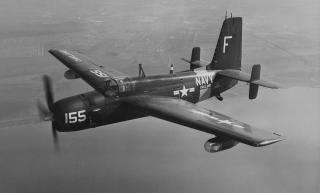
The Grumman AF Guardian was designed as a torpedo bomber at the end of World War II, but evolved into antisubmarine warfare (ASW) roles. Because ASW payloads were large and heavy, two distinct variants of the aircraft operated in hunter-killer pairs. U.S. Naval Institute Photo Archive
A relatively unknown aircraft in the annals of naval aviation, the Grumman AF Guardian presents a distinct development path that could be a model for the MQ-25. Initially designed as a torpedo bomber at the end of World War II, the Guardian was the largest single-engine piston-driven aircraft ever to operate from a carrier flight deck.10
Because of the size and weight of the payloads associated with airborne ASW, as well as the limitations of an airframe built for a different mission, the AF Guardian operated as two distinct variants in a hunter-killer pair, also known as “guppy” and “scrapper.” The hunter variant carried the large radome and radar countermeasures gear, which enabled it to scan the ocean below for periscopes or surfaced boats. The killer mounted a smaller radar and searchlight, as well as rockets, bombs, torpedoes, and depth charges, enabling it to home in on its target and attack. In addition, the killer variant later used magnetic anomaly detection and sonobuoys to enhance its ability to find submarines, especially those that may have begun to dive after initial contact with the hunter aircraft.11
Although the S-2 Tracker surpassed this rudimentary form of airborne ASW, the concept of splitting the task between two aircraft could be relevant even to a platform whose mission is entirely different, such as the MQ-25. Given that the MQ-25’s primary mission is refueling, it could spread the payload of a secondary mission, such as ASW or antisubmarine warfare (ASuW), between two aircraft. Two MQ-25s in tandem could be used for refueling larger numbers of strike aircraft while simultaneously serving as a sensor/shooter team to hunt submarines or surface ships.
Acting as a scout with some attack capability could be particularly useful, given China’s employment of large numbers of small vessels through its maritime militia, which could serve as picket ships. During the April 1942 Doolittle Raid, the B-25s launched earlier than expected when the U.S. task force encountered Japanese patrol boats. An aircraft with the loiter time of an MQ-25, rather than an expensive strike-fighter, could more efficiently deal with surveillance and ASuW tasks associated with confronting a mass of small vessels.
One could easily envision a pair of MQ-25s scanning the surface of the ocean while waiting to refuel returning strike-fighters. The circling drones could communicate with surface and aviation assets to identify targets and destroy unfriendly vessels. Previous authors in Proceedings have advocated for integrating new ASW technologies and tactics on existing carrier-based platforms, including using the MQ-25 and other aircraft in teams.12 Although the strike-fighters may be busy launching attacks or conducting combat air patrols, the concept of MQ-25 and other platforms working together should be pursued.
The Douglas A-3 Skywarrior
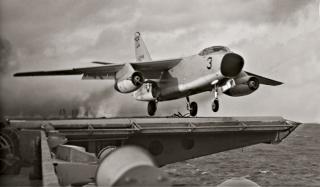
The Douglas A-3 Skywarrior was a heavy bomber intended for carrying nuclear weapons, but it ended up being most effectively used as a tanker and, later, as a dual tanker and electronic countermeasures aircraft. U.S. Naval Institute Photo Archive
The venerable Douglas A-3 Skywarrior, one of the largest and longest-serving platforms in carrier aviation history, is another example of a multirole aircraft from which the MQ-25 program can learn. First developed as a heavy bomber for carrying nuclear weapons, a mission quickly superseded by the emerging fleet ballistic-missile submarines, it later dropped conventional munitions, including mines, and conducted photoreconnaissance during the Vietnam War.
The Skywarrior was most effectively used as a tanker, and it is credited with saving roughly 380 aircraft during an 18-month stretch from 1966 to 1967.13 It was so successful at this role that a dual tanker and electronic countermeasure aircraft was created: the EKA-3 Tactical and Countermeasure Strike Support Aircraft.14 This variant of the “Whale” would loiter over the Gulf of Tonkin while jamming land-based air defenses and then refuel aircraft returning from strikes.
An MQ-25 could serve as a tanker and a supplementary jammer, contributing to, but not replacing, the Growler—useful given the high demand for electronic attack aircraft.15 The MQ-25 could focus its jamming efforts on targets in a more permissive environment, allowing more Growlers to accompany strike aircraft in suppressing enemy air defenses.
The Lockheed S-3 Viking
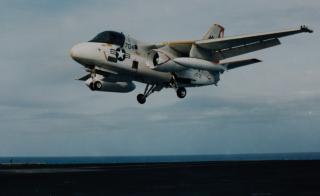
The versatile Lockheed S-3 Viking’s original role was carrier-based fixed-wing antisubmarine warfare—a role the Navy still has not replaced. The MQ-25 could augment ASW efforts with routine flights with a primary mission of refueling strike aircraft and a secondary task of providing undersea tactical awareness. U.S. Naval Institute Photo Archive
The Lockheed S-3 Viking is perhaps the most versatile aircraft ever to grace the flight deck and most relevant for the future of the MQ-25. The Viking’s original mission—carrier-based fixed-wing ASW—has gone unreplaced in the air wing. Thus, there is a glaring gap between the shore-based long-range ASW capability of the P-8A Poseidon and the short-range MH-60R Seahawk. Furthermore, there is a chance that the future air wing will shift the responsibility for providing the MH-60R/S onto the escorts to make room on the carrier for more fixed-wing aircraft.16
The P-8A is tied to land bases that may be subject to attack, is less survivable in a high-end fight, and cannot be refueled using the probe-and-drogue.17 In addition, the surface and submarine fleets are pressed for numbers. There is a need for carrier-based fixed-wing ASW. A loitering MQ-25 providing refueling near one of many choke points in the first island chain could help track enemy submarines with radar, a magnetic-anomaly detector, electronic-support gear, or even sonobuoys. Indeed, much of the Allied success against German submarines in World War II involved forcing them away from convoys, not achieving hard kills—which suggests that an MQ-25 with a mix of equipment could effectively conduct ASW by simply scaring enemy submarines.18
An MQ-25 also could team up with other ASW assets—airborne, surface ships, and submarines—and serve as a data link while flying an ASW combat air patrol.19 A P-8A has already demonstrated the ability to gain control of an MQ-25 midflight and use it for ISR.20 While the MQ-25 is less capable than a P-8A at airborne ASW, routine MQ-25 flights with the primary mission of refueling strike aircraft and the secondary task of providing undersea awareness could be an inexpensive way to augment ASW efforts.
The ES-3A Shadow served as an indications-and-warnings platform in addition to its tanking duties. The Shadow was retired in 2009, and the Navy’s land-based EP-3E ARIES signals intelligence platform is now nearing retirement, so the fleet needs a new, dedicated electronic reconnaissance and signals intelligence aircraft. Although some have sought the return of the Viking, the naval aviation enterprise would be wise to learn from the EP-3E’s history as a multimission platform.21
The A-6 Intruder
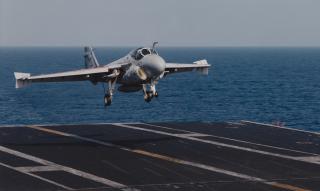
During Operation Desert Storm, A-6 Intruders launched tactical air-launched decoys, causing Iraqi defenses to fire many surface-to-air missiles. In air combat, the MQ-25 could perform a similar task, firing long-range decoys to protect strike aircraft, and also refuel fighters coming back from their attacks. U.S. Naval Institute Photo Archive
Air combat over Iraq suggests another possible concept for the MQ-25. During the first day of air strikes at the beginning of Operation Desert Storm, A-6 Intruders fired tactical air-launched decoys, which caused Iraqi air defenses to light up their radars and fire numerous surface-to-air missiles.22 This enabled other aircraft to destroy many of those air defenses. To suppress enemy air defenses in a contemporary conflict, a pair of MQ-25s could fly on a separate axis from the strike aircraft, launch long-range decoys, and return to a rendezvous point at a safe distance to refuel fighters coming back from their attack.
Questions Remain
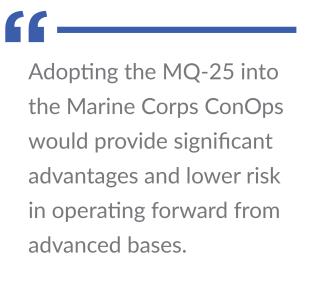
There are several questions as MQ-25 rollout commences. First, what is the weight and operating compatibility between the MQ-25 and the various ISR, EW, ASW, and ASuW packages, and how does adding a capability affect its primary mission of air-to-air refueling? Second, what does the air wing of the future look like? Extra EA-18Gs and E-2Ds, as well as larger F-35C squadrons, appear necessary. Will the embarked helicopters be moved to surface escorts to make space for the MQ-25? Does taking the refueling mission away from Super Hornets allow for fewer strike-fighters on board in exchange for the MQ-25? Will more MQ-25s be required or desired if they take on roles beyond tanking?
During the First Gulf War, each carrier air wing included three to five KA-6 tankers, but this was “not enough to carry out sustained, large-scale operations at the distances required.”23 Navy strike aircraft used Air Force tankers, something future forces may not be able to rely on in a conflict with China. Current Navy estimates have between five and eight MQ-25s in the future air wing.24 However, experts have argued that up to 12 would be needed to sustain combat operations at the distances required to mitigate Chinese threats to surface ships.25
Finally, how will naval aviation cultivate a community of operators for missions that were once accomplished by aircraft that now only exist in museums and boneyards? Aside from continuing to train a cadre of unmanned aerial vehicle pilots, it would be prudent to include aircrew from the P-8A, MQ-4C Triton, and EP-3E communities who have expertise in airborne ASW, ISR, and EW. Naval flight officers will see their responsibilities grow as unmanned aviation becomes more multirole.26 If the MQ-25 is to have an expanded job requiring more personnel, resources, and training, it deserves a dedicated community of officers and enlisted professionals.27
In taking stock of what platforms naval aviation has lost and what capabilities it needs, the Navy should see the MQ-25 as an opportunity to diversify the hangar bay, increase the range of strike aircraft, and broaden the means with which the air wing can contribute to the fight. As with so many challenges, history provides, if not precise answers, some guidelines to follow.
No comments:
Post a Comment